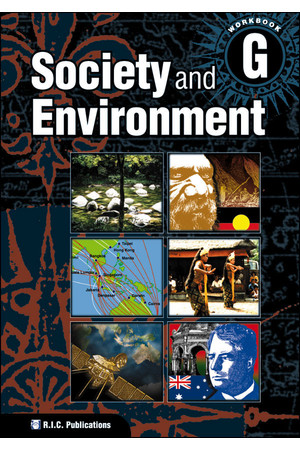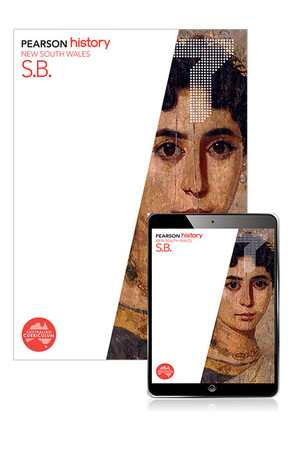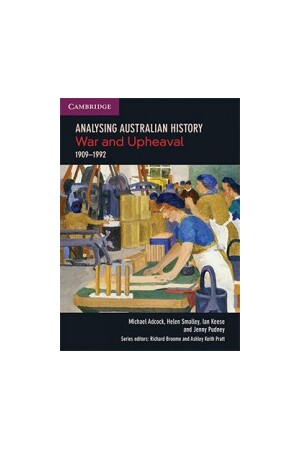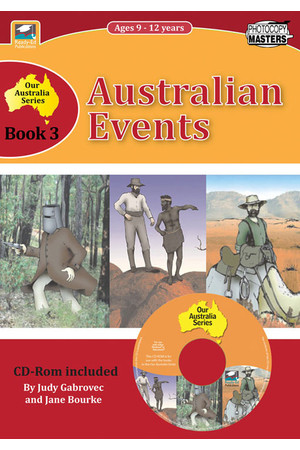Part of the series Humanities Alive Victorian Curriculum.
View all products in this series
Jacaranda Humanities Alive 9 Victorian Curriculum | Third Edition
Developed by expert Australian teachers for ALL students.
Every lesson in the new Jacaranda Humanities Alive series has been carefully designed to support teachers and to help students by sparking curiosity and engagement through discussion and Humanities skills activities.
Because both what and how students learn matter.
Learning is personal
Students: Access lessons tailored to your needs, with interactive content and support to help you progress confidently.
Teachers: Deliver engaging, differentiated lessons with built-in scaffolding and tools to support every learner.
Learning is effortful
Students: Challenge yourself, build confidence, and grow through purposeful practice on Australia’s leading platform.
Teachers: Encourage persistence with tasks that develop resilience and drive meaningful learning outcomes.
Learning is rewarding
Students: See your progress in real time, recognise your strengths, and focus on where to improve.
Teachers: Use rich analytics to track growth and target support exactly where and when it’s needed.
Table of Contents
Meet our author team ix
About this resource xi
Acknowledgements xviii
Understanding cognitive verbs
HISTORY
1 Historical concepts and skills 1
1.1 Overview 2
1.2 Historical concepts and skills 4
1.3 SkillBuilder: Historical questions
1.4 SkillBuilder: Chronology
1.5 SkillBuilder: Using historical sources
1.6 SkillBuilder: Continuity and change
1.7 SkillBuilder: Causes and consequences
1.8 SkillBuilder: Historical significance
1.9 Communicating
1.10 Review 17
2 The Industrial Revolution 21
2.1 Overview 22
2.2 How do we know about the Industrial Revolution? 24
2.3 How did the Industrial Revolution begin and develop? 27
2.4 How did changes in agriculture result in changes in society? 34
2.5 What drove the Industrial Revolution? 41
2.6 Why was coal and iron so vital? 49
2.7 What did investment have to do with the Industrial Revolution? 53
2.8 How did transport drive the Industrial Revolution? 57
2.9 How did the Industrial Revolution help create modern cities? 63
2.10 How were new challenges addressed? 68
2.11 How were children exploited and protected? 72
2.12 How did people respond to the conditions created by the Industrial Revolution? 76
2.13 How did the Industrial Revolution help create the slave trade? 81
2.14 What new ideas for society were formed during the Industrial Revolution? 89
2.15 Why did people move during the Industrial Revolution? 97
2.16 Inquiry: What was it like to grow up in an industrial town? 102
2.17 Review 103
3 Australia: Colonies to nationhood 109
3.1 Overview 110
3.2 What was the migrant experience? 112
3.3 How did migration create Australia's colonial community? 118
3.4 How did Australia change? 122
3.5 How did Australia's democracy develop? 130
3.6 Australia's fight for a 'fair go' 134
3.7 Who shaped the Australian identity? 139
3.8 Why were women important for Australia's democracy? 146
3.9 Why was there a move to Federation? 153
3.10 What were living and working conditions like? 162
3.11 Laws for a new nation 171
3.12 Inquiry: Was Australia the working man's paradise? 176
3.13 Review 178
4 Australia (1750-1914): Colonisation and conflict 185
4.1 Overview 186
4.2 How do we know about colonial policies and their impact on Aboriginal and Torres Strait Islander Peoples? 188
4.3 Where and why did European powers establish colonies in the late eighteenth century? 192
4.4 Why did conflict occur between colonists and Aboriginal and Torres Strait Islander Peoples?197
4.5 Who were the Aboriginal and Torres Strait Islander leaders who resisted colonial control? 205
4.6 What happened on the Australian colonial frontier? 208
4.7 Where was Australia Felix? 215
4.8 How did colonisers define 'civilisation' and what did this mean for Aboriginal and Torres Strait Islander Peoples? 221
4.9 Why are there different perspectives on colonial Australia? 226
4.10 How did colonisation affect the cultures, traditions and beliefs of Torres Strait Islander Peoples? 232
4.11 Inquiry: How can we better understand the impact of colonial policies on Aboriginal and Torres Strait Islander Peoples? 238
4.12 Review 240
5 Australians at war: World War I 245
5.1 Overview 246
5.2 How do we know about World War I? 248
5.3 What caused World War I? 251
5.4 Where was World War I fought? 258
5.5 What happened at Gallipoli and why was it significant? 264
5.6 Why have aspects of the Gallipoli campaign been contested? 269
5.7 What was the nature of warfare? 272
5.8 How did the war impact the Australian home front? 275
5.9 Inquiry: What were the experiences of Anzac troops on the Western Front? 282
5.10 How did World War I end and what was its lasting significance? 284
5.11 Review 291
6 China: From 1750 to present 295
6.1 Overview 296
6.2 How do we know about China from 1750 to 1918? 298
6.3 What was life like during the Qing dynasty? 301
6.4 How did foreign contact impact China? 307
6.5 Why did contact lead to conflict? 310
6.6 How did China change internally? 314
6.7 How did resistance become revolution? 319
6.8 Inquiry: What were the major events that took place between 1750 and 1918? 326
6.9 China since World War II 328
6.10 Review 336
7 Japan
7.1 Overview
7.2 What do we know about Tokugawa Japan?
7.3 How did Japan expand and modernise in the Meiji era?
7.4 What changed in the era of the World Wars?
7.5 How did Japan regrow and recover?
7.6 What changes and challenges exist today?
7.7 Inquiry: How significant was the modernising phase in the Meiji era?
7.8 Review
GEOGRAPHY
8 Geographical concepts and skills 343
8.1 Overview 344
8.2 Geographical concepts and skills 346
8.3 SkillBuilder: Geographical inquiry
8.4 SkillBuilder: Concluding and decision-making
8.5 SkillBuilder: Communicating
8.6 SkillBuilder: Describing spatial relationships in thematic maps
8.7 SkillBuilder: Describing divergence graphs
8.8 SkillBuilder: Describing patterns and correlations on a topographic map
8.9 SkillBuilder: Constructing and describing a transect on a topographic map
8.10 SkillBuilder: Constructing multiple line and cumulative line graphs
8.11 SkillBuilder: Constructing a land use map
8.12 SkillBuilder: Constructing ternary graphs
8.13 SkillBuilder: Constructing and describing isoline maps
8.14 SkillBuilder: Constructing and describing a flow map
8.15 SkillBuilder: Constructing a table of data for GIS
8.16 SkillBuilder: GIS - deconstructing a map
8.17 SkillBuilder: Interpreting a geographical cartoon
8.18 Review 357
9 Biomes and food production 361
9.1 Overview 362
9.2 What are the major biomes around the world? 364
9.3 How do we characterise biomes? 369
9.4 What are Australia's major biomes? 374
9.5 What is the importance of biomes to humans? 378
9.6 What are the major staple foods of the world? 385
9.7 How and why do we modify biomes for agriculture? 391
9.8 What types of agriculture are practised in Australia and Asia? 395
9.9 How are the world's biomes and food production interconnected? 403
9.10 How has deforestation changed the forest biome? 407
9.11 How has overfishing changed the ocean biome? 411
9.12 Inquiry: What is the impact of overfishing? 416
9.13 What are the causes and effects of land degradation? 417
9.14 Why is global biodiversity diminishing? 424
9.15 Investigating topographic maps - Coastal wetland biome in Binydjarrna (Dalywoi/ Daliwuy Bay) 429
9.16 Review 432
10 Food security 441
10.1 Overview 442
10.2 What is global food security? 444
10.3 What are the impacts of the alteration of biomes on future food production? 450
10.4 How does access to water influence crop yields? 456
10.5 What challenges does climate change pose for food security? 461
10.6 How do we expand agricultural production and distribution? 467
10.7 How do Aboriginal and Torres Strait Islander Peoples use and alter biomes for food production? 474
10.8 Inquiry: How can we resolve famine crises? 478
10.9 Investigating topographic maps - Lake Victoria as a food source 480
10.10 Review 483
11 Geographies of interconnection: Trade, technology and transportation 487
11.1 Overview 488
11.2 How are people connected to place? 490
11.3 How do we access places? 494
11.4 How does trade connect us? 499
11.5 How is Australia connected globally through export and import trade? 507
11.6 What is Australia's contribution to the global trade industry? 510
11.7 How can we make international trade fair? 517
11.8 How do Australians use technology to communicate and interconnect? 523
11.9 What is a digital divide? 526
11.10 Why is e-waste presenting such significant challenges? 531
11.11 Inquiry: What is the impact of imported manufactured products on Australian places? 536
11.12 Review 538
12 Geographies of interconnection: People and place 543
12.1 Overview 544
12.2 Why is tourism important? 546
12.3 Which places attract visitors? 553
12.4 How can the positive and negative impacts of tourism be managed? 562
12.5 How is tourism changing? 570
12.6 Aboriginal and Torres Strait Islander Peoples and tourism 577
12.7 What are the impacts of recreational tourism? 583
12.8 The rise of music tourism 588
12.9 Investigating topographic maps - Nature-driven tourism at Victoria Falls 592
12.10 Inquiry: How do cruises impact European countries? 594
12.11 Review 597
CIVICS AND CITIZENSHIP
13 Civics and Citizenship concepts and skills 601
13.1 Overview 602
13.2 Civics and Citizenship concepts and skills 604
13.3 SkillBuilder: Investigating contemporary Civics and Citizenship issues
13.4 SkillBuilder: Evaluating democratic institutions and systems
13.5 SkillBuilder: Participating in civic processes
13.6 SkillBuilder: Communicating
13.7 Review 609
14 Government and democracy 613
14.1 Overview 614
14.2 How can the Constitution be changed? 616
14.3 What is the federal government responsible for? 625
14.4 How are conflicts between federal and state government responsibilities resolved? 629
14.5 Inquiry: COVID-19 policy - state or federal responsibility? 635
14.6 Review 637
15 Laws and citizens 641
15.1 Overview 642
5.2 What are the principles of justice? 644
15.3 What is the difference between civil law and criminal law? 649
15.4 What are the key features and jurisdictions of Australia's court system? 654
15.5 How do courts and tribunals operate? 660
15.6 How do courts make laws through judgements? 667
15.7 What are the rights of the accused and the rights of victims? 673
15.8 What are the differences between Australia's legal system and Thailand's legal system? 679
15.9 Inquiry: How do some legal systems uphold fairness, equality and access but apply the death penalty? 684
15.10 Review 685
16 Citizenship, diversity and identity 689
16.1 Overview 690
16.2 What does it mean to be a global citizen? 692
16.3 How can global citizenship make a difference? 695
16.4 How do forms of media influence identity and global citizenship? 700
16.5 Inquiry: Do Australian citizens actively participate in civic life and global citizenship? 705
16.6 Review 706
ECONOMICS AND BUSINESS
17 Economics and Business concepts and skills 709
17.1 Overview 710
17.2 Economics and Business concepts and skills 712
17.3 SkillBuilder: Investigating
17.4 SkillBuilder: Interpreting and analysing data and information
17.5 SkillBuilder: Evaluating, concluding and decision-making
17.6 SkillBuilder: Communicating
17.7 Review 720
18 Australian and global economies 723
18.1 Overview 724
18.2 How does Australia trade with other economies? 726
18.3 What goods and services are imported into Australia? 733
18.4 How do global events impact global trade? 737
18.5 How do global supply chains operate? 743
18.6 What are transnational corporations? 748
18.7 How does globalisation impact the international economy? 753
18.8 Inquiry: How would you do it? 758
18.9 Review 760
19 Investment and risk 765
19.1 Overview 766
19.2 What is the role of banks and other deposit-taking institutions? 768
19.3 What are the financial risks facing consumers? 773
19.4 What are investment strategies? 777
19.5 Financial rewards for consumers 782
19.6 The importance of ethical decision-making and environmental considerations 786
19.7 How are consumers protected? 790
19.8 How can insurance help? 794
19.9 Inquiry: How can financial risks and rewards be managed? 798
19.10 Review 799
Glossary 803
Index 813
| ISBN | 9781394339587 |
| Publisher | Jacaranda |
| Product Type | Student Books, |
| Year Level | Year 9, |
Be The First To Review This Product!
Help other Teacher Superstore users shop smarter by writing reviews for products you have purchased.


















